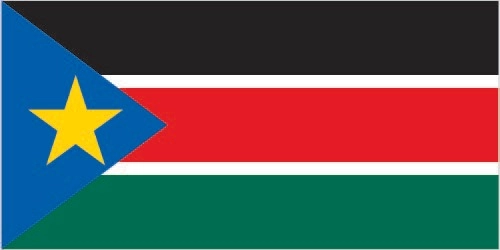
South Sudan
Country Flag Details
three equal horizontal bands of black (top), red, and green; the red band is edged in white; a blue isosceles triangle based on the hoist side contains a gold, five-pointed star; black represents the people of South Sudan, red the blood shed in the struggle for freedom, green the verdant land, and blue the waters of the Nile; the gold star represents the unity of the states making up South Sudan
note: resembles the flag of Kenya; one of only two national flags to display six colors as part of its primary design, the other is South Africa’s.
Background
South Sudan, which gained independence from Sudan in 2011, is the world’s newest country. When Sudan attained independence in 1956, the southerners were assured of full participation in the political system, but the Arab government in Khartoum reneged on its promises. Since independence, South Sudan has struggled to form a viable governing system and has been plagued by widespread corruption, political conflict, and communal violence. Implementation of a 2018 peace agreement has been stalled as South Sudanese leaders wrangle over power-sharing.

Geography
Area
total : 644,329 sq km
Climate
hot with seasonal rainfall influenced by the annual shift of the Inter-Tropical Convergence Zone; rainfall heaviest in upland areas of the south and diminishes to the north
Natural resources
hydropower, fertile agricultural land, gold, diamonds, petroleum, hardwoods, limestone, iron ore, copper, chromium ore, zinc, tungsten, mica, silver
People and Society
Population
total: 12,703,714
Ethnic groups
Dinka (Jieng) approximately 35-40%, Nuer (Naath) approximately 15%, Shilluk (Chollo), Azande, Bari, Kakwa, Kuku, Murle, Mandari, Didinga, Ndogo, Bviri, Lndi, Anuak, Bongo, Lango, Dungotona, Acholi, Baka, Fertit (2011 est.)
Languages
English (official), Arabic (includes Juba and Sudanese variants), ethnic languages include Dinka, Nuer, Bari, Zande, Shilluk
Religions
Christian 60.5%, folk religion 32.9%, Muslim 6.2%, other <1%, unaffiliated <1% (2020 est.)
Population growth rate
4.65% (2024 est.)
Government
Government type
presidential republic
Capital name: Juba
Executive branch
chief of state: President Salva KIIR Mayardit (since 9 July 2011)
head of government: President Salva KIIR Mayardit (since 9 July 2011)
Economy
Economic overview
low-income, oil-based Sahelian economy; extreme poverty and food insecurity; COVID-19 and ongoing violence threaten socioeconomic potential; environmentally fragile; ongoing land and property rights issues; natural resource rich but lacks infrastructure
Real GDP (purchasing power parity)
$20.01 billion (2017 est.)
$21.1 billion (2016 est.)
$24.52 billion (2015 est.)
Real GDP per capita
$1,600 (2017 est.)
$1,700 (2016 est.)
$2,100 (2015 est.)
Exports
$4.499 billion (2023 est.)
$5.811 billion (2022 est.)
$4.652 billion (2021 est.)
Exports – partners
China 51%, Singapore 29%, UAE 10%, Germany 4%, Uganda 3% (2023)
Exports – commodities
crude petroleum, refined petroleum, forage crops, gold, scrap iron (2023)
Imports
$4.443 billion (2023 est.)
$6.402 billion (2022 est.)
$4.037 billion (2021 est.)
Imports – partners
Uganda 33%, UAE 26%, Kenya 14%, China 10%, USA 3% (2023)
Imports – commodities
garments, cement, other foods, iron bars, cereal flours (2023)

Export structure by product group in 2023 (% of total trade) (UNCTAD)
The export structure of a nation comprises the diversity, composition, and value of its internationally traded goods and services, serving as a vital indicator of the nation’s economic health, competitive position, and developmental status. In the case of South Sudan, the export structure is primarily dominated by crude petroleum, which exposes its economy to significant external vulnerabilities. Therefore, the implementation of strategies aimed at diversifying exports is essential for fostering sustainable economic stability and long-term growth.

Poverty and vulnerable employment in South Sudan
In 2023, an alarming 71 percent of South Sudan’s total workforce was engaged in vulnerable employment, which is characterized by a lack of job security, low wages, and the absence of social protections such as health insurance and labor rights. This category includes own-account workers, who are self-employed individuals without employees, like street vendors and small-scale farmers, as well as contributing family workers, who assist in family-owned businesses or farms without formal remuneration. These jobs are frequently informal and precarious, leaving workers exposed to economic challenges and exploitation, ultimately driving them toward poverty. The repercussions of vulnerable employment extend beyond individual workers, impacting families and communities and perpetuating cycles of hardship that are difficult to escape.
Understanding poverty level significance at $2.15 per day
In 2016, 67 percent of the population ( 7 million people) in South Sudan lived in poverty at $2.15 per day. The poverty level at $2.15 per day (measured in 2017 purchasing power parity, or PPP) is a key global benchmark used by the World Bank to define extreme poverty in low-income countries. It indicates:
1. Basic Survival Threshold
• People living below $2.15 per day struggle to afford essential needs such as food, clean water, shelter, healthcare, and education.
2. Economic Underdevelopment
• A high percentage of a country’s population living below this threshold suggests low economic productivity, high unemployment, and weak social safety nets.
3. Inequality and Social Vulnerability
• It reflects deep income inequality and a lack of access to opportunities for upward mobility.
• People in this category are more vulnerable to shocks like food price increases, climate disasters, or health crises.
4. Policy Challenges
• Governments need targeted interventions such as social welfare programs, job creation, and improved access to education and healthcare to reduce poverty.
A country's export structure is a reflection of its level of development and productive capacities
The export structure of a country refers to the composition, diversity, and value of the goods and services it sells to other countries. It provides key insights into the country’s economic health, competitiveness, and level of development. Productive capacities of a country refer to its ability to produce goods and services efficiently and sustainably over time. These capacities are shaped by various factors, including human capital, natural resources, infrastructure, private sector, development, technology & innovation, institutions & governance, financial systems trade & market access.
Here’s what the export structure and productive capacities of a country typically indicate:
- Level of Economic Development
- Developed economies usually export high-value manufactured goods, technology, and services.
- Developing economies often rely on raw materials, agricultural products, or low-value manufactured goods.
- Industrial and Sectoral Strengths
- A strong presence of high-tech or industrial goods (e.g., machinery, electronics) suggests a well-developed manufacturing sector.
- A dominance of commodities (e.g., oil, minerals, agricultural products) indicates reliance on natural resources.
- Export Diversification
- A diverse export base (multiple industries) makes a country’s economy more stable and resilient to global price shocks.
- A concentrated export base (few key products) makes it vulnerable to market fluctuations.
- Trade Partnerships and Dependence
- If exports are heavily dependent on a single country or region, the economy is more exposed to geopolitical and trade risks.
- A wide range of trading partners indicates stronger global integration.
- Competitiveness and Value Addition
- Exporting mainly raw materials (e.g., crude oil instead of refined petroleum) suggests limited industrial processing capacity.
- A high share of finished and high-tech goods suggests strong value addition and competitiveness.
South Sudan-Sanitation
South Sudan – Proportion of population served with at least basic sanitation
In 2022, proportion of population served with at least basic sanitation for South Sudan was 16.1 %. Proportion of population served with at least basic sanitation of South Sudan increased from 15.8 % in 2020 to 16.1 % in 2022 an absolute change of 0.3 percentage points (pp) between 2020 and 2022.
South Sudan – Proportion of urban population served with at least basic sanitation
In 2022, proportion of urban population served with at least basic sanitation for South Sudan was 41.8 %. Proportion of urban population served with at least basic sanitation of South Sudan increased from 23.9 % in 2013 to 41.8 in 2022 an absolute change of 17.9 pp between 2013 and 2022.
South Sudan – Proportion of rural population served with at least basic sanitation
In 2022, proportion of rural population served with at least basic sanitation for South Sudan was 9.3 %. Proportion of rural population served with at least basic sanitation of South Sudan increased from 5.4 % in 2013 to 9.3 % in 2022 an absolute change of 3.9 pp between 2013 and 2022.
South Sudan – Proportion of population served with at least basic sanitation: A Global Perspective
The ongoing lack of safe sanitation is a critical challenge that demands our immediate collective action to prevent the tragic deaths of countless individuals each year, marking a significant public health crisis. Access to safe sanitation is a fundamental human right that must be guaranteed for all. In 2022, nearly 9 million people, or 84 percent of South Sudan’s population, faced the dire consequences of inadequate sanitation, in stark contrast to countries like Vietnam, China, and Thailand, where only 8 percent, 5 percent, and 1 percent respectively lacked these essential services. With the global average at around 6 percent, it is vital that we unite to improve sanitation access in the marginalized regions of Sub-Saharan Africa.
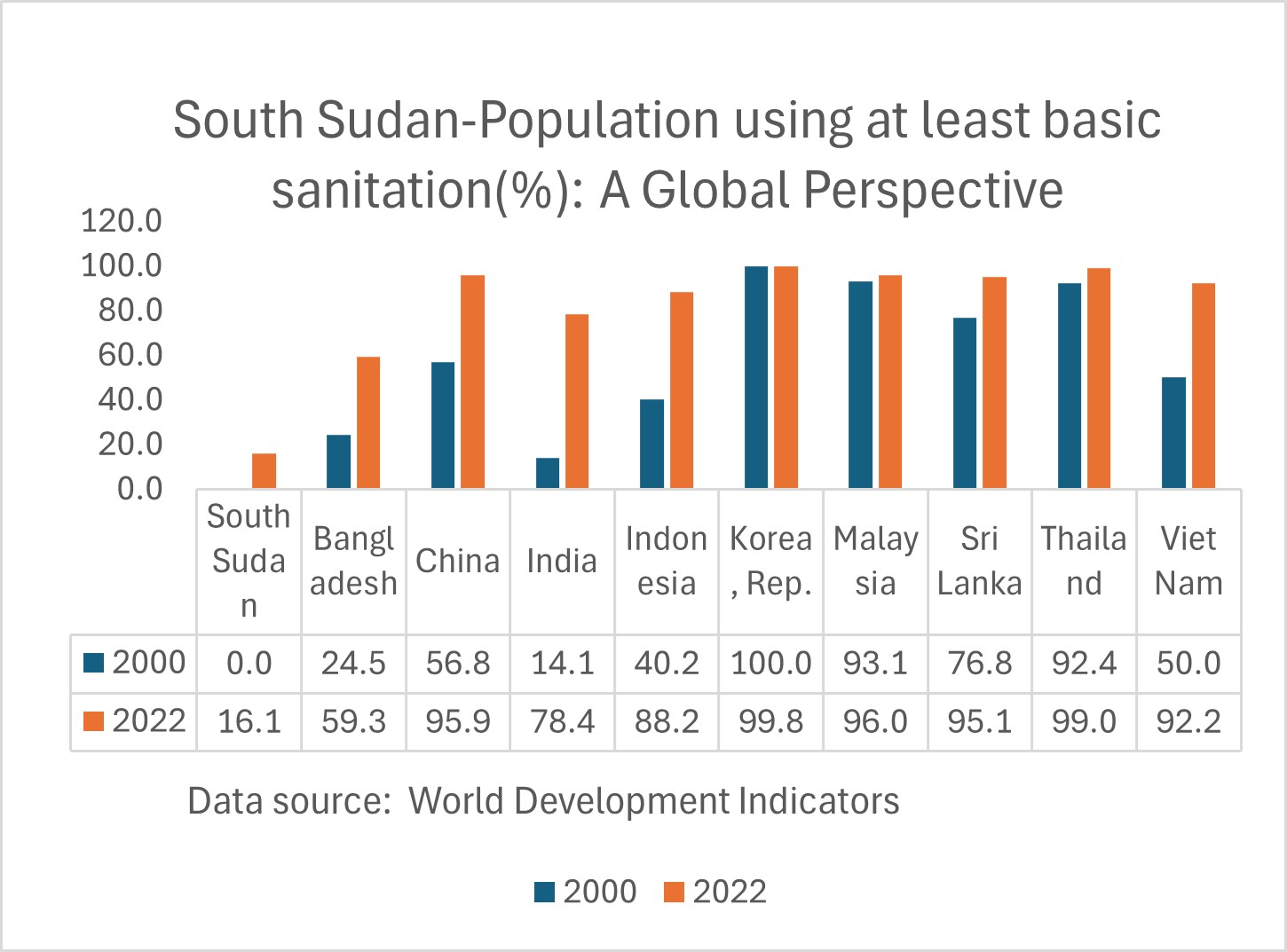
South Sudan- Proportion of rural population served with at least basic sanitation: A Global Perspective
In 2022, nearly 8 million people in rural South Sudan or about 91 percent of the population lacked access to basic sanitation facilities highlighting a stark contrast with nations like Vietnam, Sri Lanka, and Thailand, where the figures were just 12 percent, 5 percent, and 2 percent, in 2022. This absence of safe sanitation is not merely an urgent issue but a serious reality that calls for our immediate collective action, as it contributes to countless preventable deaths each year. Safe sanitation is a fundamental human right that every person is entitled to without exception. Therefore we must unite in solidarity to advocate for this vital right across Sub-Saharan Africa where the urgency is critical and the potential for meaningful community transformation is both significant and essential for the dignity and health of all involved

South Sudan-Water Supply
South Sudan – Proportion of total population served with at least basic water
In 2022, the proportion of the population served with at least basic drinking water in South Sudan was 41.2 %. Th proportion of the population served with basic drinking water in South Sudan increased from 41.0% in 2020 to 41.2% in 2022, an absolute change of 0.2 pp between 2020 and 2022.
South Sudan – Proportion of urban population served with at least basic water
In 2022, the proportion of the urban population served with at least basic water in South Sudan was 70 %. The proportion of the urban population served with at least basic water in South Sudan increased from 56.3 % in 2013 to 70 % in 2022, an absolute change of 13.7% between 2013 and 2022.
South Sudan – Proportion of rural population with at least basic water
In 2022, the proportion of the rural population served with at least basic water in South Sudan was 33.6 %. Between 2013 and 2022, the proportion of the rural population served with at least basic drinking water in South Sudan declined from 37.9 % in 2013 to 33.6 % in 2022, an absolute change of 4.3 pp between 2013 and 2022.
South Sudan- Proportion of population served with at least basic drinking water: A Global Perspective
Access to safe drinking water is a fundamental human right that demands immediate action worldwide. In 2022, around 6.6 million people in South Sudan, roughly 60% of the population, lacked this essential resource, resulting in a severe public health crisis. In stark contrast, individuals in Thailand and 98% of the populations in Vietnam and Bangladesh had reliable access to safe drinking water that same year. This inequality underscores the urgent need for change in Sub-Saharan Africa, the only developing region where many still lack the resources to improve their lives. We must strengthen our efforts to close this gap and ensure that everyone has access to safe drinking water, as this issue goes beyond convenience; it is an ethical duty we share as a global community committed to justice and equality.

Seychelles- Proportion of rural population served with at least basic drinking water: A Global Perspective
In 2022, it is concerning that 66 percent of the rural population in South Sudan, or about 5.7 million people, did not have access to safe drinking water, highlighting a serious humanitarian crisis that needs our immediate attention. In contrast, countries like Thailand, Bangladesh, and Vietnam have achieved nearly complete access to safe drinking water for their rural populations, with rates of 100 percent, 98 percent, and 97 percent respectively. This significant difference not only shows the governance issues faced by many Sub-Saharan African nations but also emphasizes the need for collective action to enhance living conditions for vulnerable communities throughout the region.
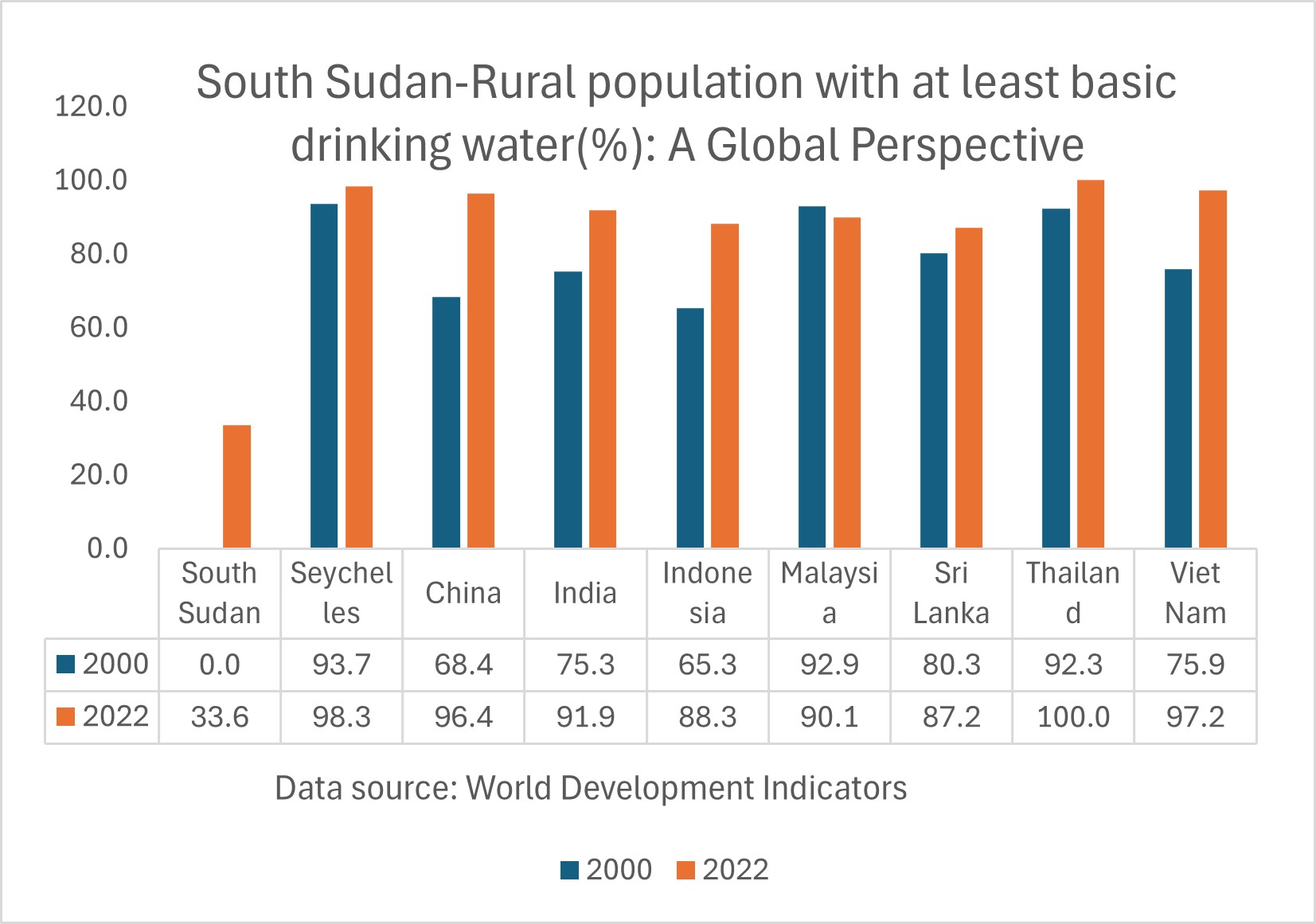
South Sudan-Access to Electricity
South Sudan- Access to electricity (% of population)
In 2022, the proportion of the population with access to electricity in South Sudan was 8.4 %. The proportion of the population with access to electricity in South Sudan increased from 1.5% in 2010 to 8.4% in 2022, an absolute change of 6.9 pp between 2010 and 2022.
South Sudan- Access to electricity (% urban population)
In 2022, the proportion of the urban population with access to electricity in South Sudan was 15%. The proportion of urban population with access to electricity in South Sudan increased from 8.1% % in 2000 to 15% in 2022, an absolute change of 6.9 pp between 2000 and 2022.
South Sudan- Access to electricity (% of rural population)
In 2022, the proportion of the rural population with access to electricity in South Sudan was 1.7 %. The proportion of the rural population with access to electricity in South Sudan increased from 1 % in 2010 to 1.7% in 2022, an absolute change of 0.7 pp between 2010 and 2022.
South Sudan- Proportion of population served with electricity: A Global Perspective
In 2022, around 92 percent of South Sudan’s population faced the harsh reality of living without electricity, affecting nearly 10 million individuals reliant on this essential service for their daily lives and well-being. This urgent situation highlights the importance of learning from countries like Vietnam, Thailand, Sri Lanka, and Malaysia, which have made significant progress toward universal electricity access. Sub-Saharan Africa urgently needs transformative changes to enhance the quality of life for all citizens. The lack of reliable electricity is not merely an inconvenience; it poses a major barrier to development, health, education, and economic opportunities vital for improving living conditions and fostering hope for a sustainable future in South Sudan.
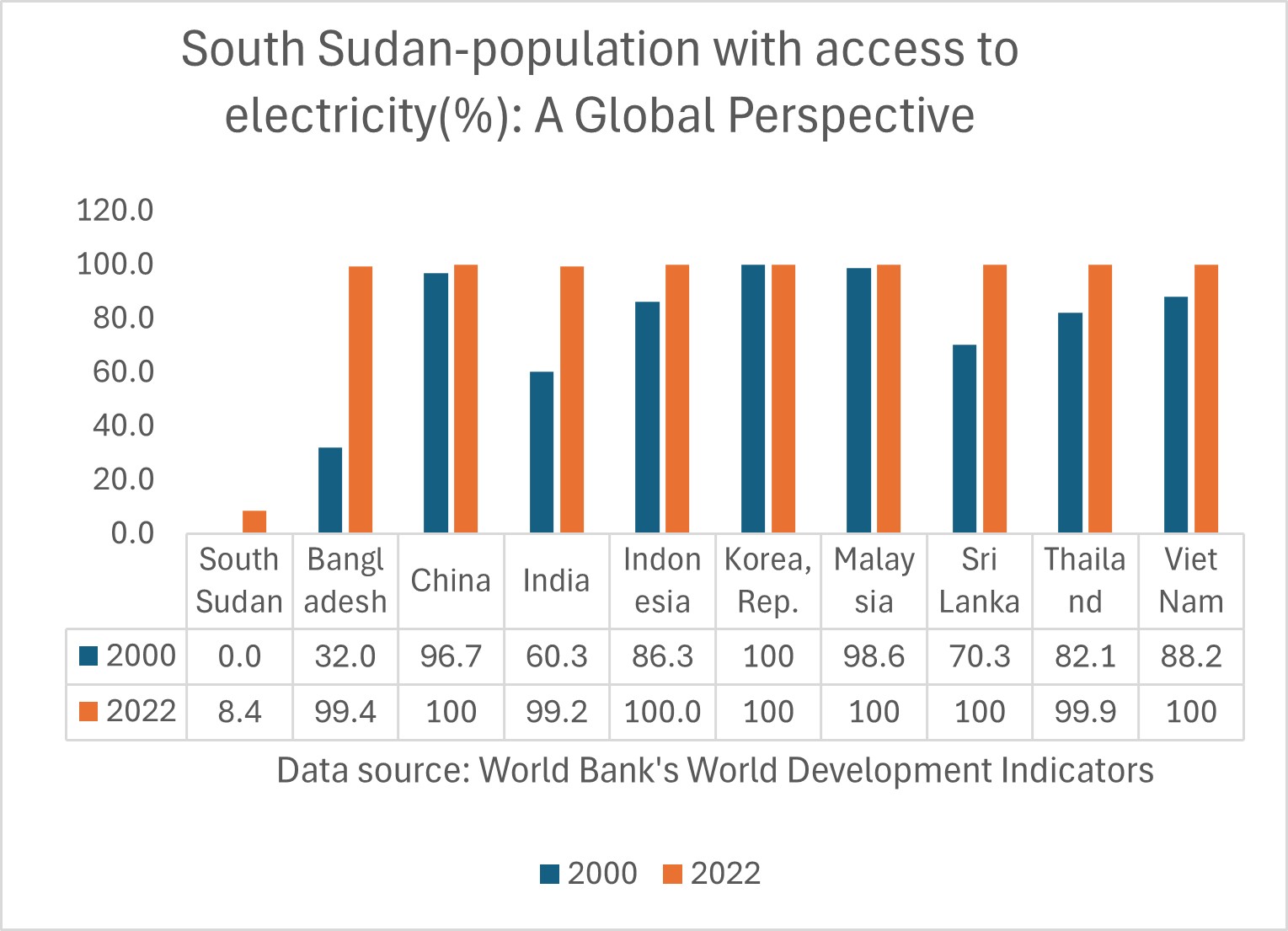
South Sudan- Proportion of rural population served with electricity: A Global Perspective
In 2022, an alarming 98 percent of the rural population in South Sudan faced the harsh reality of living without electricity, starkly highlighting the disparity compared to countries like Vietnam, Thailand, and Sri Lanka, where all rural residents have access to this essential resource. Even in India and Bangladesh, 99 percent of rural inhabitants enjoy reliable electricity, underscoring the vast gulf in energy access. These figures reveal the urgent need for transformative governance reforms across Sub-Saharan Africa, which are crucial not only to ensure that every community has dependable electricity but also to empower them towards self-sufficiency and a more sustainable, equitable, and prosperous future.
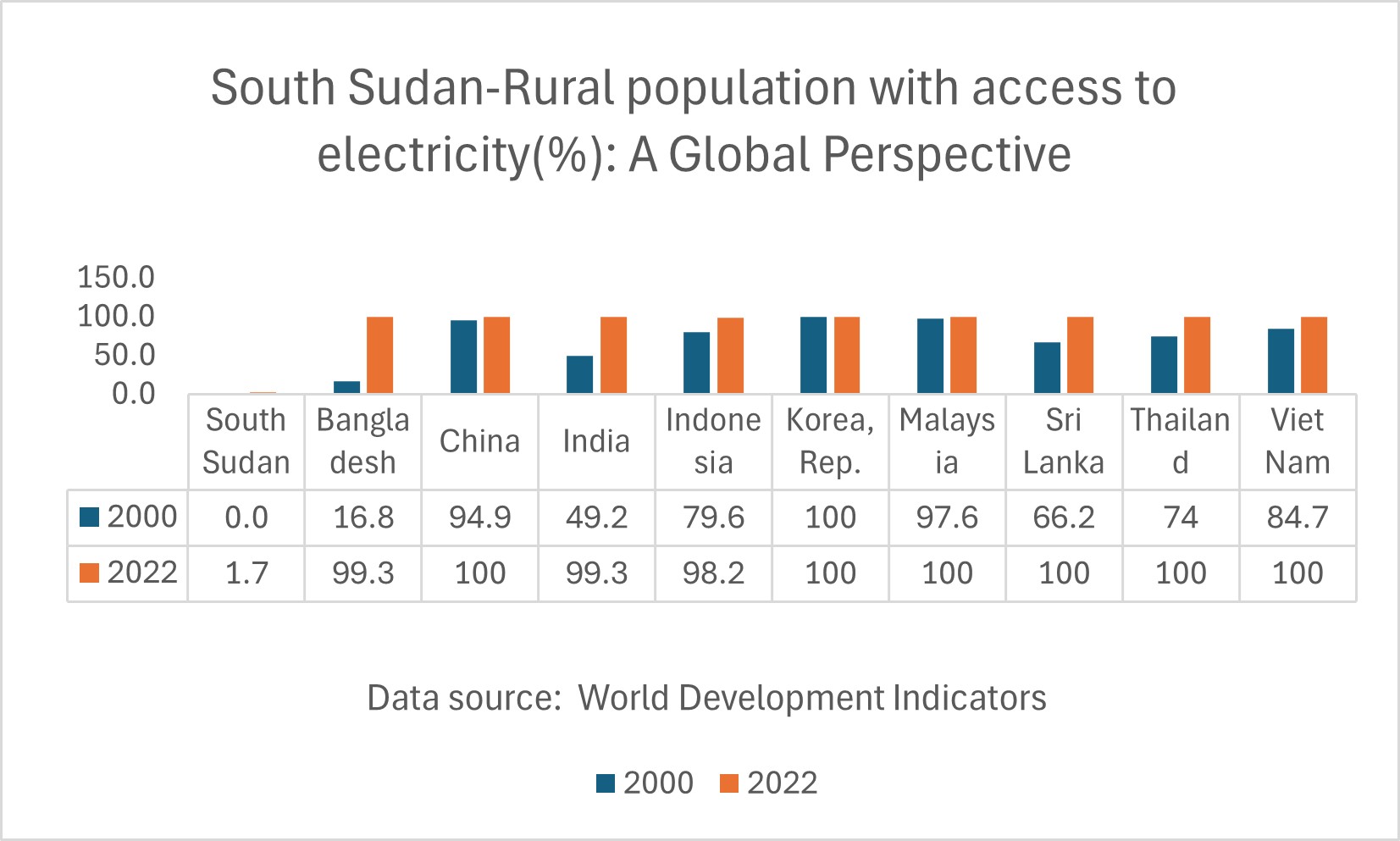
South Sudan: Health outcomes
South Sudan-Life expectancy: A Global Perspective
Over the past seventy years, we have seen life expectancy improve significantly worldwide, yet there are still noticeable gaps, especially in Sub-Saharan Africa. While the global average life expectancy rose from 47 years in 1950 to 71 years in 2021, many countries in Sub-Saharan Africa have not experienced similar progress. For example, South Sudan’s life expectancy went from 28 years in 1960 to 55 years in 2022. In contrast, nations like South Korea and the Maldives have made extraordinary strides, with life expectancy increasing from 54 years to 83 years and from 39 years to 81 years, respectively, between 1960 and 2022. The low life expectancy in several Sub-Saharan nations highlights critical issues such as poverty, lack of healthcare, and governance problems. This situation calls for urgent action to empower communities and support sustainable healthcare initiatives, ensuring that the benefits of global progress are shared more fairly.
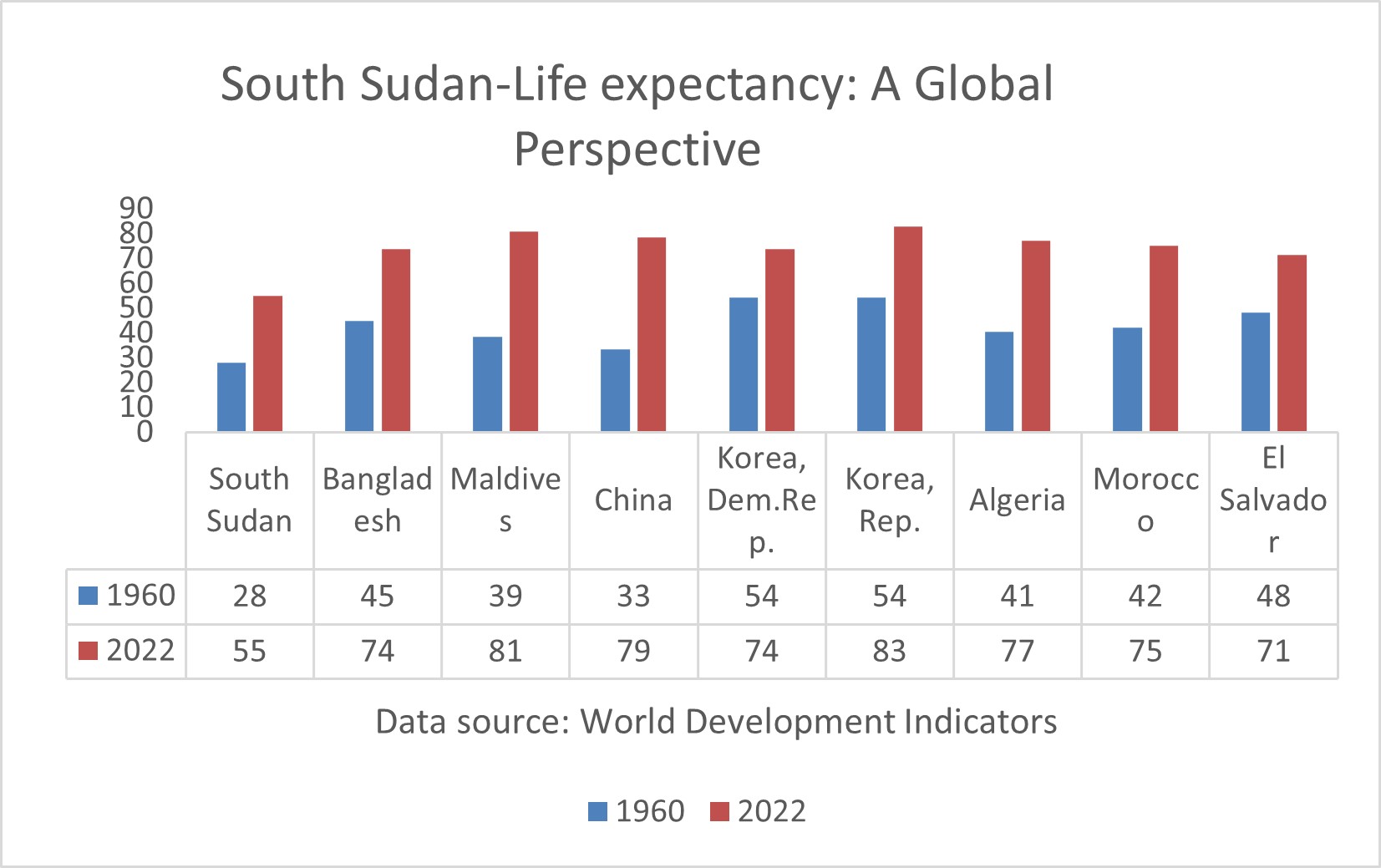

South Sudan-Mortality rate, under-5 (per 1,000 live births): A Global Perspective
The under-five mortality rate has significantly decreased since 1950 due to improved living standards, healthcare, nutrition, and clean water, yet the challenge persists. For example, South Sudan reduced its under-five mortality rate from 292 in 1980 to 99 in 2022. In contrast, countries like Bangladesh and India have achieved substantial reductions, with rates falling from 206 and 169 in 1980 to just 29 in 2022. These statistics underscore the need for improved healthcare systems and collaborative investment in sustainable health initiatives to address child mortality and enhance health outcomes for vulnerable populations in Sub-Saharan Africa.

South Sudan-Maternal mortality ratio (per 100,000 live births): A Global Perspective
South Sudan’s maternal mortality ratio is a significant concern, with recent figures revealing a troubling reality. While the decline from 1687 in 2000 to 1223 in 2020 is notable, it starkly contrasts with the much lower rates in Bangladesh, India, and Vietnam, which reported 123, 103, and 46 in 2022. This ongoing issue highlights the persistent problem of pregnancy-related deaths driven by a high birth rate and urgent maternal health challenges requiring immediate action. The alarming statistics reveal critical weaknesses in the healthcare system and the chronic underfunding affecting many Sub-Saharan African countries. The pronounced disparities in maternal health outcomes compared to other developing regions demand urgent attention, advocating for significant investments in healthcare, as the lives and well-being of mothers and their children in South Sudan remain at risk.
